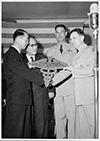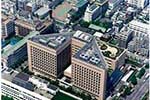History
History

- Dr. Rudolf B. Teusler,
Founder
This hospital is a living organism
designed to demonstrate
in convincing terms
the transmuting power of Christian love
when applied
in relief of human suffering.
Rudolf B. Teusler(1933)
| 1900 | Dr. and Mrs. Teusler arrive in Japan. |
| 1901 | Dr. Teusler establishes an almshouse in Tsukudajima. |
| 1901 | St. Luke's Hospital is founded. |
| 1904 | A nursing school is established with a first class of 10 students. |
| 1912 | St. Luke's Pharmacy is established in Ginza. |
| 1913 | St. Luke's Board of Sponsors (Mr. Shigenobu Okuma, Mr. Shinpei Goto, Mr. Tokutaro Sakai, Mr. Yoshitaro Sakatani, and Mr. Eiichi Shibusawa) decides to construct a new hospital. |
| 1917 | St. Luke's Hospital changes its name to St. Luke's International Hospital. |
| 1918 | Dr. Teusler is assigned to Vladivostok as Head Physician of the Japan-Siberia-USA Red Cross with 30 doctors and nurses. |
| 1920 | St. Luke's International Hospital Affiliated Advanced Nursing School is established. |
| 1923 | The Great Kanto Earthquake completely destroys the hospital. |
| In the aftermath of the earthquake, operations start as a "US Government Department of Health Field Hospital". | |
| 1924 | Construction of a temporary hospital comprising 40-50 beds is completed . |
| 1925 | The temporary hospital is destroyed by fire (all 140 inpatients were safely evacuated). |
| Japan's first Central Laboratory is set up in the new temporary hospital. | |
| 1927 | Japan's first Public Health Nursing Department is established. |
| 1929 | Japan's first Medical Social Services Department is established. |
| 1933 | The new hospital (the current Old Building) is completed with 6 floors above ground and one floor below ground. |
| An American-style residency training system is introduced, the first for Japan. | |
| 1936 | The St. Luke's Chapel is completed (and remains intact in the Old Building today). |
| 1945 | Great Tokyo Air Raids: At the behest of the metropolitan government, hospital relief corps is frequently deployed. |
| After the war, the US Armed Force GHQ requisition all facilities for use as the US Army Hospital. | |
| Medical services and 71 workers are transferred to the municipal hospital at the former 14 Akashi-cho. | |
| 1947 | Medical teams are sent to areas stricken by Typhoon Kathleen: 500 patients treated and 280 people vaccinated. |
| 1948 | St. Luke's International Hospital is designated as a Travel Medical Examination Office for overseas travelers. |
| 1949 | St. Luke's International Hospital is designated as a practicum training hospital for medical school graduates. |
| Medical teams are sent to areas stricken by Typhoon Kitty: 209 patients treated. | |
| 1954 | One week comprehensive medical checkups begin, the first for a private hospital. |
| 1956 | Japan's first Medical Records Management Department is set up. |
| Hospital buildings are returned by the US Army. The Japanese national flag is flown on the roof. | |
| The cross on top of the main building is dedicated, and the Service of Thanksgiving is held for the restoration of St. Luke's International Hospital. | |
| 1957 | The "Iron Lung" respirator is introduced. |
| 1964 | The establishment of St. Luke's College of Nursing is approved. |
| 1968 | The Coronary Care Unit (CCU) is established, the first for a general hospital in Japan. |
| 1972 | The Medical Checkup Center (currently the Center for Preventive Medicine) is established. |
| 1973 | The Intensive Care Unit (ICU) is established. |
| 1977 | CT scanners are installed. |
| 1980 | Plans for a new hospital building begins. |
| 1984 | 3 out of the 8 American Legation Monuments are transferred to the American Embassy. |
| 1985 | The hospital begins performing coronary catheterizations. |
| 1986 | A medical team is sent to the Tokyo G7 Summit held in the State Guest House. |
| 1988 | The pipe organ, built in France, is installed in the Chapel. |
| 1990 | Doctors begin staffing the Kiyosato St. Luke's Clinic (until July 1991). |
| MRI machines are installed. | |
| 1992 | The new hospital (currently the Main Hospital Building) is completed, the first 100%-private room hospital in Japan. |
| 1994 | St. Luke's Garden is completed. |
| 1995 | 4 doctors and 11 nurses are dispatched to the areas stricken by the Great Hanshin Earthquake. |
| Tokyo Subway Sarin Gas Attack occurs; 640 victims treated (110 of them hospitalized). | |
| Routine hospital-acquired infection surveillance (per United States CDC guidelines) is initiated, the first for Japan. | |
| 1996 | The Dental Residency Program is approved. |
| The St. Luke's School of Nursing building is completed. | |
| 1997 | The Palliative Care Unit (PCU) and hospice program are established. |
| The Emergency Medical Center is established (approved as an Emergency Care Center in 1999). | |
| St. Luke's International Hospital is designated as an AIDS Treatment Center. | |
| 1998 | The Teusler Memorial House is relocated. |
| The St. Luke's International Hospital Redevelopment Plan is completed and the commemoration ceremony is held. | |
| 1999 | The Learning Center for patients opens. |
| 2000 | St. Luke's International Hospital is designated as a regional Perinatal Medical Center. |
| 2001 | Japan's 15th brain death case is cared for at St. Luke's. |
| 2002 | 100th anniversary of the hospital's founding is commemorated. |
| 2003 | The electronic medical chart system, "SMILE III", is initiated. |
| 2004 | 35 medical workers dispatched to areas stricken by the Niigata Chuestsu Earthquake (October 23). |
| 2005 | The Ambulatory Care Center for Children is established and an after-hours clinic in collaboration with Chuo-ku Medical Association is started. |
| Volunteers are sent to areas in Pakistan stricken by the Kashmir Earthquake. | |
| 2006 | The Department of Medical Genetics opens. |
| The Gastroenterology Center opens. | |
| 2007 | The road approaching the hospital is officially nicknamed "St. Luke's Street". |
| 13 workers are dispatched to areas stricken by the Niigata Chuetsu Offshore Earthquake (July 16). | |
| 2008 | St. Luke's International Hospital is designated as a Regional Core Cancer Treatment Hospital. |
| 2009 | The Oncology Center opens. |
| 2010 | The St. Luke's Birth Clinic opens. |
| 2011 | A new electronic medical chart system, "SMILE for...", begins operation. |
| The Great East Japan Earthquake occurs; 200 patients are stranded at the hospital. | |
| The Cardiovascular Center opens. | |
| The robotic surgical system, "da Vinci", is introduced. | |
| St. Luke's International Hospital is designated as a Regional Medical Care Support Hospital. | |
| 2012 | Accreditation is awarded by Joint Commission International (JCI), the United States' leading hospital accrediting organization. St. Luke's MediLocus opens. |
| 2014 | Changed to St Luke’s International University |
| The Liaison Center was opened. | |
| The Thoracic Center was opened | |
| 2015 | Joint Commission International(JCI)accreditation was renewed |
| Renewal of certification by the Japan Council for Evaluation of Postgraduate Clinical Training | |
| The Organization for Economic Cooperation and Development (OECD) highly acclaimed the Quality Indicator approach used at St. Luke’s International Hospital in its “Healthcare Quality Review of Japan.” | |
| Won the highest Dr Kwang Tae Kim Grand Award of the International Hospital Federation | |
| 2016 | Joint Commission International(JCI)accreditation was renewed |
| 2017 | The Robot Operation Center was opened. |
| The Center for Cancer Genomics was opened. | |
| The Center for Integrated Sports Medicine was opened. | |
| 2018 | The Anesthesia and Perioperative Medicine was opened. |
| Joint Commission International(JCI)accreditation was renewed | |
| 2019 | Adlescents and Young Adults Survivorship Center opened. |
| Magnet accreditation is awarded to St. Luke's by the American Nurse Credentialing Center(ANCC). |
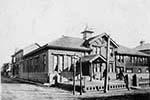
- St. Luke's Hospital is founded, 1901
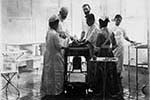
- Operation scenery, 1904
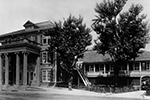
- St. Luke's Hospital changes its name to St. Luke's International Hospital, 1917
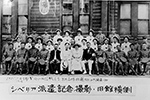
- Dr. Teusler is assigned to Vladivostok as Head Physician of the Japan-Siberia-USA Red Cross with 30 doctors and nurses, 1918
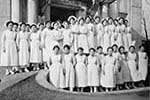
- St. Luke's International Hospital Affiliated Advanced Nursing School is established, 1920
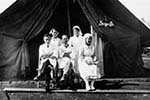
- The Great Kanto Earthquake completely destroys the hospital
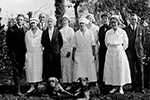
- 1923 The foreign staff
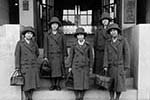
- 1949 Japan's first Public Health Nursing Department is established, 1927
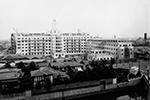
- The new hospital (the current Old Building) is completed, 1933

